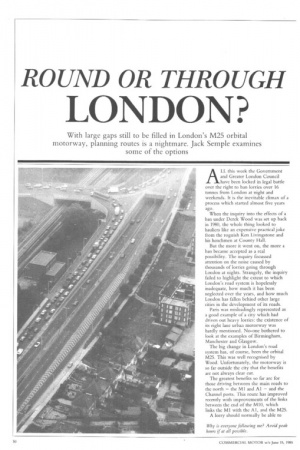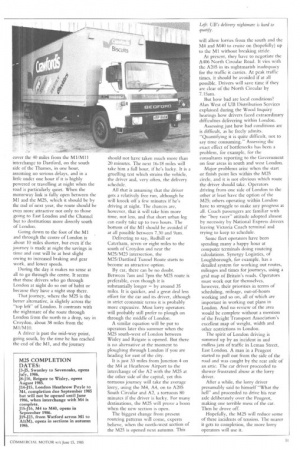ROUND OR THROUGH
Page 52

Page 53

If you've noticed an error in this article please click here to report it so we can fix it.
LONDON?
With large gaps still to be filled in London's M25 orbital motorway, planning routes is a nightmare. jack Semple examines some of the options
ALL this week the Government and Greater London Council have been locked in legal battle over the right to ban lorries over 16 tonnes from London at night and weekends. It is the inevitable climax of a process which started almost five years ago.
When the inquiry into the effects of a ban under Derek Wood was set up back in 1980, the whole thing looked to hauliers like an expensive practical joke from the roguish Ken Livingstone and his henchmen at County Hall.
But the more it went on, the more a ban became accepted as a real possibility. The inquiry focussed attention on the noise caused by thousands of lorries going through London at nights. Strangely, the inquiry failed to highlight the extent to which London's road system is hopelessly inadequate, how much it has been neglected over the years, and how much London has fallen behind other large cities in the development of its roads.
Paris was misleadingly represented as a good example of a city which had driven out heavy lorries: the existence of its eight lane urbaii motorway was hardly mentioned. No-one bothered to look at the examples of Birmingham, Manchester and Glasgow.
The big change in London's road system has, of course, been the orbital M25. This was well recognised by Wood. Unfortunately, the motorway is so far outside the city that the benefits are not always clear cut.
The greatest benefits so far are for those driving between the main roads to the north — the M1 and Al — and the Channel ports. This route has improved recently with improvements of the links between the end of the M10, which links the M1 with the Al, and the M25.
A lorry should normally be able to cover the 40 miles from the Ml/M11 interchange to Dartford, on the south side of the Thames, in one hour, assuming no serious delays, and in a little under one hour if it is highly powered or travelling at night when the road is particularly quiet. When the motorway link is fully open between the M1 and the M25, which it should be by the end of next year, the route should be even more attractive not only to those going to East London and the Channel but to destinations more directly south of London.
Going down to the foot of the MI and through the centre of London is about 10 miles shorter, but even if the journey is made at night the savings in time and cost will be at best slight owing to increased braking and gear work, and lower speeds.
During the day it makes no sense at all to go through the centre. It seems that those drivers who go through London at night do so out of habit or because they have a night stop there.
That journey, where the M25 is the better alternative, is slightly across the "top left" of London. It contrasts with the nightmare of the route through London from the north to a drop, say in Croydon, about 38 miles from the Ml/M10.
A driver is past the mid-way point, going south, by the time he has reached the end of the Ml, and the journey should not have taken much more than 20 minutes. The next 16-18 miles will take him a full hour, if he's lucky. It is a gruelling test which strains the vehicle, the driver and, very often, the delivery schedule.
All that is assuming that the driver gets a relatively free run, although he will knock off a few minutes if he's driving at night. The chances are, however, that it will take him more time, not less, and that short urban leg can easily take up to two hours. The bottom of the M1 should be avoided if at all possible between 7.30 and 9am.
Delivering to say, Redhill or Caterham, seven or eight miles to the south of Croydon and near the M25/M23 intersection, the M25/Dartford Tunnel Route starts to become an attractive option.
By car, there can be no doubt. Between 7am and 7pm the M25 route is preferable, even though it is substantially longer — by around 35 miles. It is quicker, and a great deal less effort for the car and its driver, although in strict economic terms it is probably more expensive. Most lorry operators will probably still prefer to plough on through the middle of London.
A similar equation will be put to operators later this summer when the M25 south-west of London between Wisley and Reigate is opened. But there is no alternative at the moment to ploughing through London if you are heading for east of the city.
It is just 33 miles from Junction 4 on the M4 at Heathrow Airport to the interchange of the A2 with the M25 at the other side of the capital, yet this tortuous journey will take the average lorry, using the M4, A4, on to A205 South Circular and A2, a tortuous 80 minutes if the driver is lucky. For many destinations, the M25 will prove a boon when the new section is open.
The biggest change from present routeing patterns will come, experts believe, when the north-west section of the M25 is opened next autumn. This will allow lorries from the south and the M4 and M40 to cruise on (hopefully) up to the M1 without breaking stride.
At present, they have to negotiate the A406 North Circular Road. It vies with the A205 in its nightmarish inadequacy for the traffic it carries. At peak traffic times, it should be avoided if at all possible. Drivers will save time if they are clear of the North Circular by 7.15am.
But how bad arc local conditions? Alan West of UB Distribution Services explained during the Wood Inquiry hearings how drivers faced extraordinary difficulties delivering within London.
Assessing just how bad conditions are is difficult, as he freely admits. "Quantifying it is quite difficult, not to say time consuming.Assessing the exact effect of bottlenecks has been a problem, for example, for the consultants reporting to the Government on four areas in south and west London.
Major problems arise when the start or finish point lies within the M25 circle, and it is not obvious which route the driver should take. Operators driving from one side of London to the other at least have the option of the M25; others operating within London have to struggle to make any progress at all. Coach passengers are familiar with the "boy racer" attitude adopted almost by necessity by National Express drivers leaving Victoria Coach terminal and trying to keep to schedule.
Sonic fleet operators have been spending many a happy hour at computer terminals doing routeing calculations. Synergy Logistics, of' Loughborough, for example, has a detailed system for working out routes, mileages and times for journeys, using a grid map of Britain's roads. Operators must work out for themselves,
however, their priorities in terms of scheduling, mileage, out-of-hours working and so on, all of which are important in working out plans in London. And no review of the area would be complete without a mention of the Freight Transport Association's excellent map of weight, width and other restrictions in London.
The spirit of London driving is summed up by an incident in and endless jam of traffic in Leman Street, East London. A man in a Peugeot started to pull out from the side of the road and was caught by the rear axle of an artic. The car driver proceeded to shower frustrated abuse at the lorry driver.
After a while, the lorry driver presumably said to himself "What the hell" and proceeded to drive his rear axle deliberately over the Peugeot, making one terrible mess of the car. Then he drove off.
Hopefully, the M25 will reduce some of these incidents of tension. The nearer it gets to completion, the more lorry operators will use it.




































































































